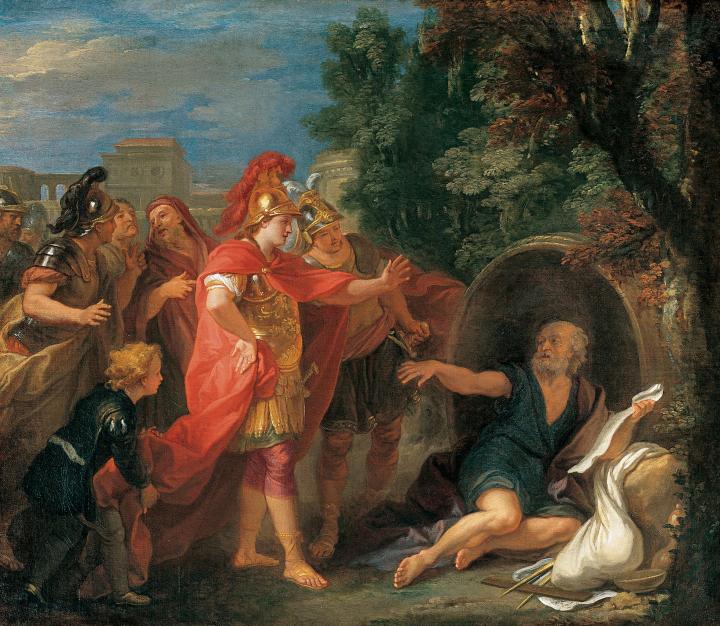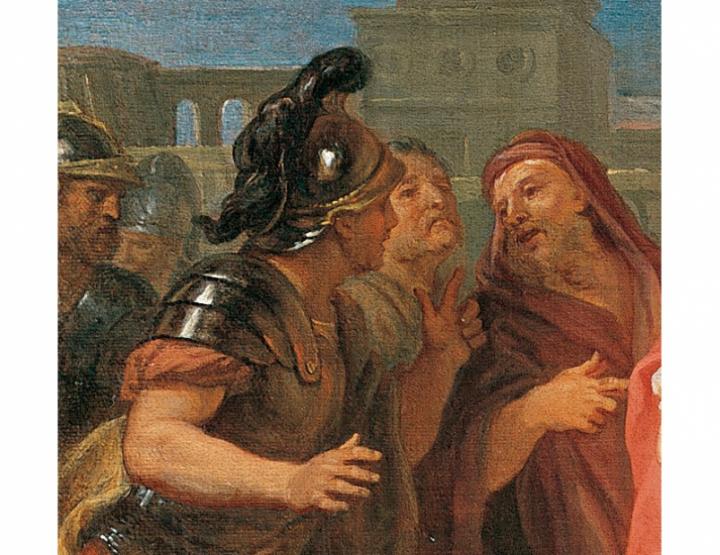
Louis de Silvestre, Alexander and Diogenes, about 1750, oil on canvas. Purchased through the Mrs. Harvey P. Hood W'18 Fund; P.993.6.
Based on the Learning to Look method created by the Hood Museum of Art. This discussion-based approach will introduce you and your students to the five steps involved in exploring a work of art: careful observation, analysis, research, interpretation, and critique.
HOW TO USE THIS RESOURCE
1. Print out this document for yourself.
2. Read through it carefully as you look at the image of the work of art.
3. When you are ready to engage your class, project the image of the work of art on a screen in your classroom.
4. Use the questions provided below to lead the discussion.
Step 1. Close Observation
Ask students to look carefully and describe everything they see. Start with broad, open-ended questions like:
* What do you see in this painting?
* What else do you see?

Then become more and more specific as you move your students’ eyes throughout the work with questions like these:
What do you notice about:
* The figures in the painting?
* Their dress?
* Their poses?
* Their facial expressions?
* The objects they have with them?
* What do you notice about the background or setting?
* What do you notice about the artist’s technique?
* The colors he used?
* His skill?
* His ability to paint people?
Step 2. Preliminary Analysis
Once you have listed everything you can see about the object, begin asking simple analytic questions that will deepen your students' understanding of the work.

For instance:
* What is each of the figures doing?
* What is their relationship to each other?
* How do they relate to the background?
* Who might these people be?
After each response, always ask, “How do you know?” or “How can you tell?” so that students will look to the work for visual evidence to support their theories.
Step 3. Research
At the end of this document, you will find some background information on this object. Read it or paraphrase it for your students.
Step 4. Interpretation
Interpretation involves bringing your close observation, preliminary analyses, and any additional information you have gathered about an art object together to try to understand what a work of art means. There are often no absolute right or wrong answers when interpreting a work of art. There are simply more thoughtful and better informed ones. Challenging your students to defend their interpretations based upon their visual analysis and their research is most important.
Some basic interpretation questions for this object might be:
* Is there a moral to this story? What did Alexander learn from Diogenes?
* What does this painting tell us about French society and its values in 1750?
* What does it tell us about the skill and knowledge of French painters in the eighteenth century?
Step 5. Critical Assessment and Response
Critical assessment and response involves a judgment about the success of a work of art. This step is optional but should always follow the first four steps of the Learning to Look method. Art critics often engage in this further analysis and support their opinions based on careful study of and research about the work of art.
Critical assessment involves questions of value. For instance:
* Would the French court have liked a painting like this? Why or why not?
* Was the artist successful and skillful in expressing his ideas? Why do you think so?
Another realm that this fifth stage can encompass is one’s response to a work of art. Different from assessment, the realm of response can be much more personal and subjective.
* How do you feel about this painting?
* Do you like it?
* Does it move you?
* Is it relevant to your lives?
* Does the moral of this story still apply today?
Background Information
Louis de Silvestre, French, 1675-1760
Alexander and Diogenes
About 1750
Oil on canvas
This French painting is based on several ancient stories that tell of a meeting between Alexander the Great and the philosopher Diogenes. Alexander the Great was the King of Macedonia from 356 to 323 B.C.E. He was a military genius who conquered most of the land known to the ancient Greeks, forging a great empire. He died at the age of 32. Diogenes was a philosopher who also lived during the fourth century B.C.E. A philosopher is a person who devotes their life to thinking about the big questions, seeking answers to the way things are, or the way life should be. Diogenes was considered a cynical philosopher. He despised material possessions and lived extremely simply, close to nature. In fact, it is believed that he made his home in an empty wine barrel.
As the stories tell, Alexander was such a great admirer of Diogenes that when he finally met the philosopher, he offered him anything he wanted from his vast kingdom. Diogenes replied that all he wanted from Alexander was for him to stand aside because he was blocking the sun.
This response was rather rude considering that Alexander was a very important man. But rather than being insulted, Alexander was impressed by Diogenes' truthfulness and he said that if he were not Alexander, he would choose to be Diogenes.
Alexander's wealth and position in this painting is contrasted with Diogenes' simplicity. Alexander is set among his soldiers and servants, dressed in golden armor with a flowing red cape. The light shines directly upon him and a classical palace fills the background. Diogenes is dressed simply and lies upon the ground inside his wine barrel. His only possessions are his instruments of study, a compass, and a roll of paper. He is set against a natural landscape.
The painting captures the climactic moment in the story when Diogenes responds to Alexander's offer. Diogenes gestures with his hand as he asks the king to move out of the light.
This subject was an unusual one for a French painter, since it had the potential of casting doubt over the authority of the king. The French court under the reign of Louis the XV was lavish and in 1750 the king was largely unpopular. Louis de Silvestre appears to have painted this work outside the country in Dresden, Germany, where he had become the First Painter to the King of Poland. The character behind Alexander, who directs his gaze toward the viewer, appears to be a self-portrait of the artist.